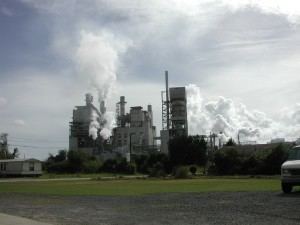 | ||
The pulp and paper industry comprises companies that use wood as raw material and produce pulp, paper, paperboard and other cellulose-based products.
Contents
- Paper
- History of the paper industry
- List of main countries by production quantity
- List of main company groups by production quantity
- List by net sales
- Manufacturers and suppliers for the industry
- References
The industry is dominated by North American (United States and Canada), northern European (Finland, Sweden, and North-West Russia) and East Asian countries (such as East Siberian Russia, China, Japan, and South Korea). Australasia and Brazil also have significant pulp and paper enterprises. The United States had been the world's leading producer of paper until it was overtaken by China in 2009.
The industry is criticized by environmental groups like the Natural Resources Defense Council for unsustainable deforestation and clearcutting of old-growth forest. The industry trend is to expand globally to countries like Russia, China and Indonesia with low wages and low environmental oversight. According to Greenpeace, farmers in Central America illegally rip up vast tracts of native forest for cattle and soybean production without any consequences, and companies who buy timber from private land owners contribute to massive deforestation of the Amazon Rainforest.
Considering that the pulp and paper industry is a practitioner of nanotechnology, then it is easily the world's largest.
Paper
The pulp is fed to a paper machine where it is formed as a paper web and the water is removed from it by pressing and drying.
Pressing the sheet removes the water by force; once the water is forced from the sheet, a special kind of felt, which is not to be confused with the traditional one, is used to collect the water; whereas when making paper by hand, a blotter sheet is used instead.
Drying involves using air and/or heat to remove water from the paper sheets; in the earliest days of paper making this was done by hanging the sheets like laundry; in more modern times various forms of heated drying mechanisms are used. On the paper machine the most common is the steam heated can dryer.
History of the paper industry
The first mechanised paper machine was installed at Frogmore Mill, Apsley, Hertfordshire in 1803, followed by another in 1804. The site operates currently as a museum.
List of main countries by production quantity
According to statistic data by RISI, main producing countries of paper and paperboard, not including pulp, in the world are as follows:
List of main company groups by production quantity
The world's main paper and paperboard company groups are as follows. (Some figures are estimates.):
List by net sales
In 2008, the top 10 forest, paper and packaging products companies were, according to a report by PricewaterhouseCoopers:
Manufacturers and suppliers for the industry
Leading manufacturers of capital equipment with over $1 billion in annual revenue for the pulp and paper industry include:
